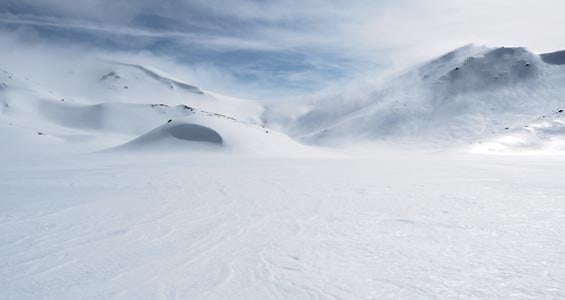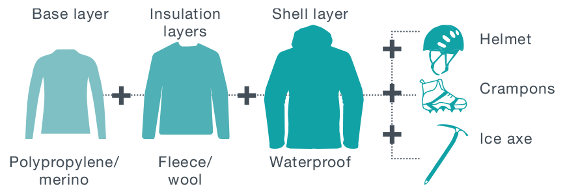Outside the Great Walks season (1 May 2025 – 23 October 2025)
During the winter season, the Tongariro Northern Circuit is not a Great Walk and has reduced facilities.
There is increased risk from snow, ice, avalanche terrain and sub-zero temperatures.
Suitable for people with alpine skills, equipment and experience. You must:
- know how to navigate if cloud or snow covers the marker poles and you cannot see them
- know where avalanches are a risk and be able to rescue someone if an avalanche occurs
- have the equipment and skills to prevent a slide on icy terrain
- have the clothing for sub-zero temperatures and be able to survive if the weather get worse.
Fees and bookings
Outside of the Great Walks season, hut fees are reduced and bookings are not required. Full information can be found in the fees and booking section for this track.
Expect challenging track conditions
Track surface: Track is covered in snow and very icy in sections.
Snow and ice is common in higher areas and sometimes on lower areas. Deep snow can hide track markers. At times, surface conditions can be hard ice.
View current conditions on webcams on the GeoNet website: Tongariro webcam | Ngauruhoe webcam | Ruapheu North webcam
 South Crater in winter
South Crater in winter
Image: Zhi Yuen Yap ©
Conditions are cold, wet and windy
During the winter months, Tongariro is frequently cold, wet and windy. Dress for the conditions.

Avalanches are possible from July to October
Most of the track is simple terrain, however some sections of the Tongariro Northern Circuit track pass through challenging and complex avalanche terrain, including where it crosses over Red Crater between South Crater and Emerald Lakes
Avalanches are most common during the winter and spring (July to October) but can occur before or after that period. The avalanche hazard can change with very little warning.
If you are going into places avalanches could occur, be sure you:
- have checked the New Zealand Avalanche Advisory for Tongariro and the Avalanche Terrain Exposure Scale (ATES) for Tongariro National Park.
- have the skills for the ATES class you are going into
- take an avalanche transceiver, avalanche probe and a snow shovel. Know how to use these tools.
Expect reduced hut facilities
Hut facilities are reduced.
- Gas cookers are not provided – you need to bring your own cooking stove.
- Running water may not be available. Water can be obtained from the outside water tank; if this is frozen, then from the nearest watercourse or by melting snow. We recommend that you treat all stream water in case of giardia or other bugs.
- No DOC rangers.
- No emergency radio facilities.
Be totally self-sufficient
You need to be totally self-sufficient. In addition to what to take in the Great Walks season, you also need:
- food for at least two extra days
- stove and gas for cooking
- lighter or matches
- alpine equipment: ice axe and crampons
- avalanche equipment: beacon, snow shovel, avalanche probe
- personal locator beacon
- mountain radio or satellite messenger (optional).